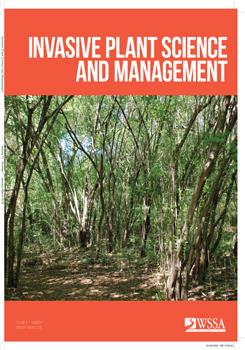Since its introduction to the United States in 1852, Chinese privet (Ligustrum sinense Lour.) has spread throughout the Southeast, invading many natural areas. Manual control by cutting or shredding is one of the most common strategies many land managers employ. However, rapid sprouting from the root collar and lateral roots commonly results in poor control. Cutting followed by either glyphosate or triclopyr application to the stumps is generally effective, but the efficacy of these herbicides in relation to treatment timing and L. sinense root collar diameter has not been evaluated. The objective of this experiment was to determine the effectiveness of glyphosate and triclopyr cut stump treatments compared with cutting alone at spring and fall timings across a range of L. sinense size classes. Studies were conducted at two locations in Auburn, AL. Treatments included cut stump no herbicide, cut stump glyphosate (120 g L-1), or cut stump triclopyr (90 g L-1). Treatments were applied to at least 50 experimental units each at April and November timings. Root collar diameter was recorded for each stem, stems were cut 2.5 cm above the ground, and herbicide treatments were applied within 30 s. Ligustrum sinense mortality and sprouting were quantified 6, 12, and 18 mo after treatment. Both glyphosate and triclopyr amine were very effective in controlling L. sinense at both spring and fall timings. However, glyphosate provided slightly better results than triclopyr when lateral sprouting was included. Application timing also was significant, with a lower percentage of sprouting following November treatments than April treatments. Stem size influenced treatment success, as larger stumps tended to sprout more than smaller stumps. These results indicate L. sinense can be controlled with cut stump herbicide treatment using either glyphosate or triclopyr with spring or fall timings at concentrations much lower than typically used.
How to translate text using browser tools
1 March 2018
The Influence of Treatment Timing and Shrub Size on Chinese Privet (Ligustrum sinense) Control with Cut Stump Herbicide Treatments in the Southeastern United States
Stephen F. Enloe,
Sarah E. O'Sullivan,
Nancy J. Loewenstein,
Eve Brantley,
Dwight K. Lauer
ACCESS THE FULL ARTICLE
Individual plant treatment
invasive plant control





